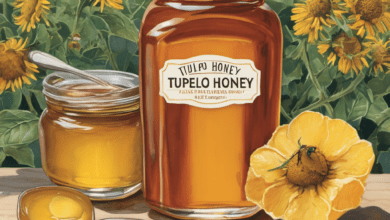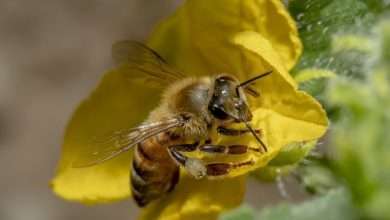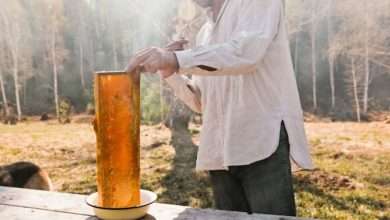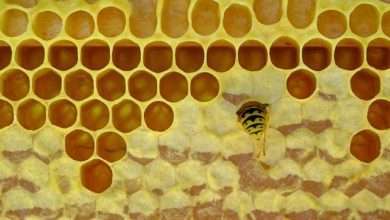Honey Color
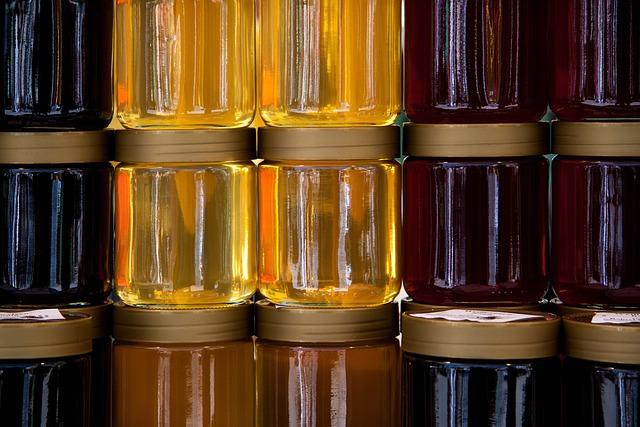
There are up to seven categories into which the USDA classifies honey. These are the categories into which the categories are named:
• Water white
• Extra white
• White
• Extra light amber
• Light amber
• Amber
• Dark amber
What is the Pfund Scale?

The Pfund scale is a continuous scale on which actual color grading is done. A normal glass wedge in an amber color that ranges from light to dark is what a Pfund color grader is.
In a wedge-shaped container, the honey is deposited, compared to the scale, and the distance from one end of the wedge to the location where the colors match is measured. Consequently, the length of 0 to 144mm is used to depict the honey color.
Despite the grade being accompanied by a color designation usually, in the United States, a factor in determining grades of honey is not color.
Applying these United States grade requirements for the color of honey does not need the use of the Pfund color grader, which is not an officially recognized tool for establishing color designation.
In contrast, the transmittance of freshly prepared caramel-glycerin solution that is the same color as the honey is measured at a wavelength of 560 nanometers, through a sample of 3.15 centimeters, as opposed to the transmittance of pure glycerin.
The nectar source (the blossoms) visited by the honey bees determines the difference in flavor and color of honey.
In actuality, there are more than 300 distinct kinds of honey that are offered in the US, each of which comes from a different floral source.
Depending on where the honey bees buzzed, the color of honey can range from nearly colorless to dark brown, and its flavor can be anywhere from mildly delectable to noticeably robust. Honey comes in two broad flavors: light and dark. Light honey has a gentler flavor.
A few regions only produce certain types of honey, but depending on floral source location, every state produces honey. Besides, most countries globally produce honey.
Here are some of the most popular honey flower kinds found in the United States. Get in touch with a neighborhood beekeeper, beekeeping group, or honey packer to find out more about the varieties of honey that are readily available there.
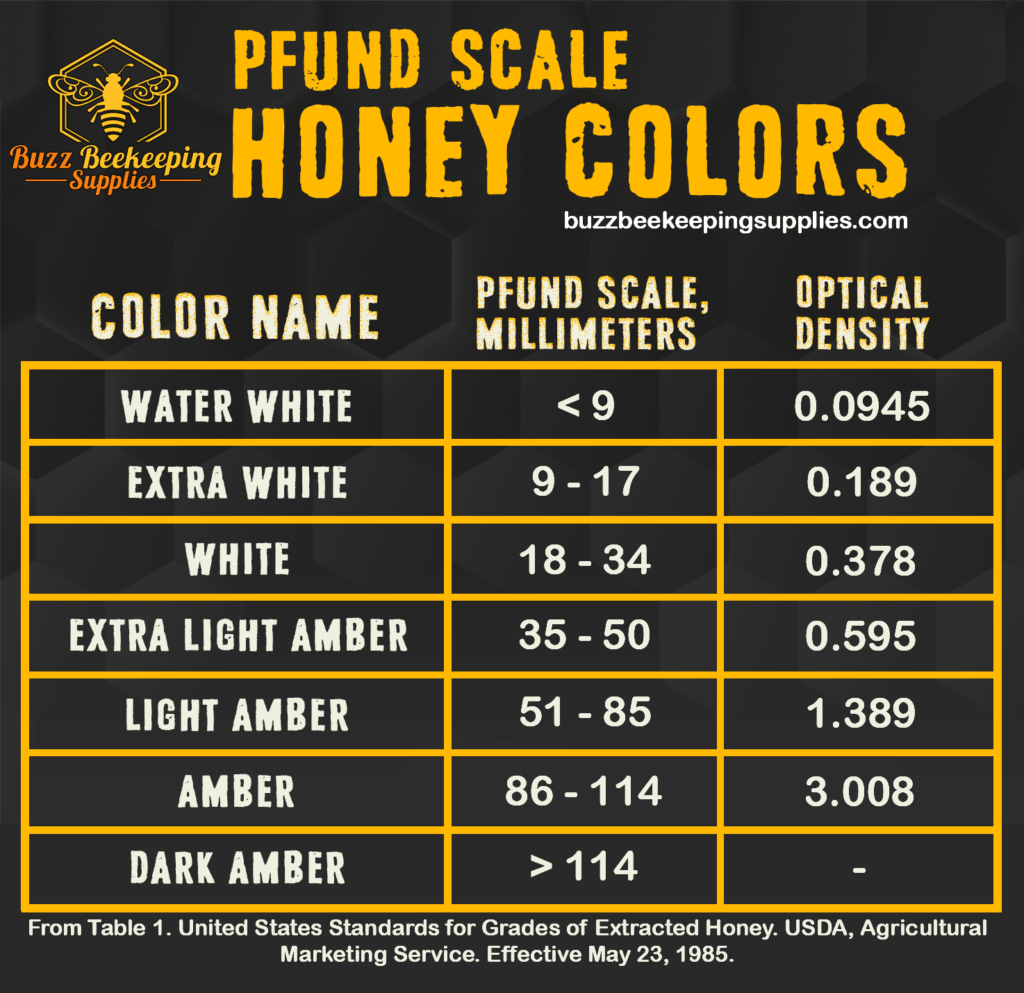
Visit the honey locator if you need assistance locating a honey packer or a particular source of flowers.
ALFALFA
The color of this honey is light with a pleasingly mild flavor and aroma. Additionally, the purple blossoms are used in making Alfalfa honey that is produced throughout Canada and the United States in large quantities.
AVOCADO
Apart from avocado honey featuring a rich, buttery taste, its color is dark and it is from the California avocado blossoms where it is gathered.
BLUEBERRY
The nectar is extracted from the blueberry bush’s tiny white blooms, and it results in a honey that is often light amber and has a rich, well-balanced flavor. In Michigan and New England, blueberry honey is produced.
BUCKWHEAT
Compared to some light honey, there are more antioxidant compounds contained in buckwheat honey as it has been found.
Additionally, in the honey color chart, this honey is considered to be full-bodied and dark. Minnesota, New York, Ohio, Pennsylvania, and Wisconsin in the United States as well as parts of eastern Canada are the main places where buckwheat honey is produced.
CLOVER
In flavor, there is a pleasing, mild taste in clover honey. Compared to other groups of plants in the United States, honey production has need contributed more by clovers.
Additionally, for honey production, red clover, Alsike clover, and white and yellow sweet clovers are most important. There is a variation in color from water white to light amber to amber in clover honey and the variation depends on the type of source clover and the area.
EUCALYPTUS
One of the more diverse plant genera, with over 500 unique species and several hybrids, is the one from which eucalyptus honey is derived.
Eucalyptus honey has a wide range of color and flavor variations, as may be expected from such a diverse group of plants, although it often has a richer flavor and a faint medicinal aroma. California is where it is made.
FIREWEED
In the Northern and Pacific states and Canada, there is a wonderful bee pasture created by a perennial herb from which light-colored honey known as Fireweed is produced.
Fireweed is a plant that grows in open areas of the woods. It can reach heights of three to five feet and spikes lovely pinkish flowers.
ORANGE BLOSSOM
Parts of Texas, Southern California, and Florida are where orange blossom honey is produced. The honey known as the orange blossom is often light in color, and mild in flavor, with a subtle citrus taste and a fresh aroma. It is frequently made from a combination of citrus sources.
SAGE
The color of sage honey is light and when it comes to flavor, this honey is mild but delightful plus it is heavy bodied.
Honey packers like to blend this honey with other honey to slow down granulation because it has an extremely slow granulation rate.
TUPELO
This honey features a mild, distinctive taste and it usually has a light golden amber with a greenish cast color plus it is heavy bodied.
The Florida panhandle is where this premium honey known as Tupelo honey is produced. The granulation of this type of honey is extremely slow thanks to the content of fructose in it is high.
WILDFLOWER
The term “wildflower honey” is frequently used to refer to honey from various and unspecified flower sources.
HONEY BLENDS
A unique and consistent taste and color of honey are created by blending in most honey, especially those supplied in bulk despite the availability of different types of honey.
Compared to darker kinds of honey, water white honey commands a much higher price since Americans prefer light honey as it turns out, the lighter the better. The American preference for the lightest maple syrup that does not pack on all the flavors is similar to this consumer preference.
FAQs

What is the color of honey?
Depending on where the honey bees buzzed, the color of honey can range from nearly colorless to dark brown, and its flavor can be anywhere from mildly delectable to bold.
Dark-colored honey is stronger in taste than light-colored honey but light-colored honey is milder and that is a general thumb rule.
Which color of honey is best?
There is a more pronounced, and sharper taste in honey with a dark color while there is a delicate, soft taste in pale and clear kinds of honey and that is one rule of thumb.
What gives honey color?
The pollen that is gathered by a hive to generate honey gives it its color. Different colors of honey from season to season can be produced in a single hive because bees collect honey nearly year-round and at different times of the year, plants blossom.
Is natural honey dark?
Raw and unfiltered varietal honey is virtually always hazy and opaque, with their natural pollen and flavor still intact, despite the fact that their colors can range from what beekeepers refer to as “water white” to “motor-oil black.”
You will not be dissatisfied if you choose your honey based on cloudiness rather than hue.
Why is raw honey dark?
This problem can be caused by honey’s improper storage. Apart from the container used to store honey being tightly covered, the area should be cool and dry. Your honey will be safe to eat indefinitely despite a change in flavor and the darkening it will have over time.
